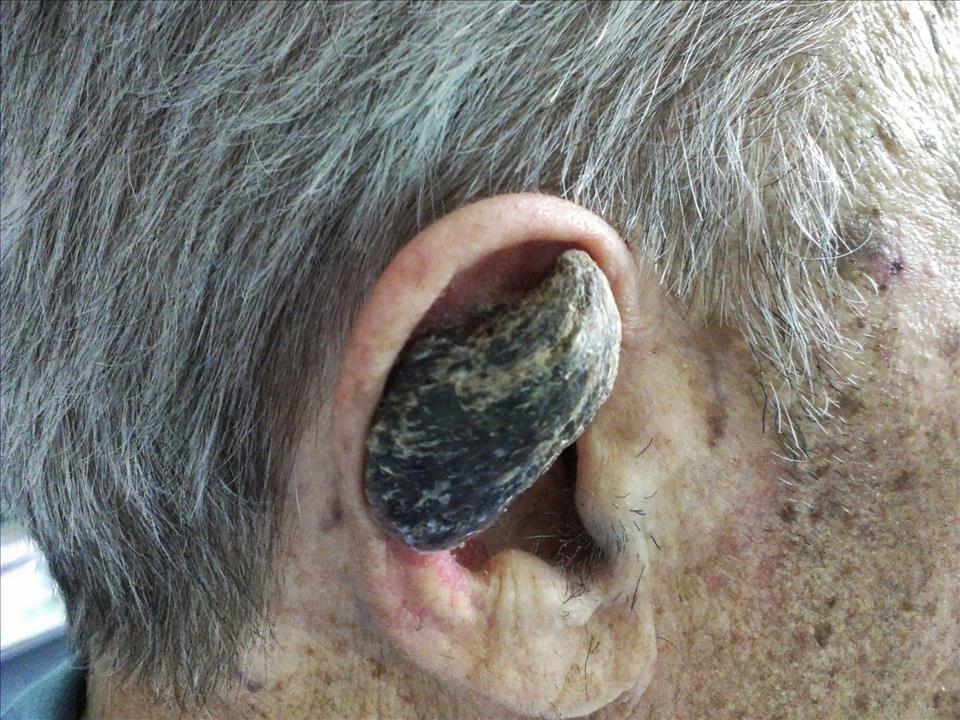
Why Some Humans Grow Horns
Chestnuts are fascinating little entities – remnants of toe pads that were present in the prehistoric relatives of both domestic and wild horses. They're also unique to each animal; you can think of them as an individual fingerprint.
Chestnuts are made of keratin, the same material found in the outer layer of skin. It's protective, waterproof and durable, giving resilience and strength. It's also found in hair and nails, which allow for important functions like trapping heat and providing sensory information to the brain.
Samuel Wolfenden is a farrier who often shares social media posts of chestnut removals.
The hooves and horns of animals are no different. Keratin-based and developed from the skin, they are designed for functions such as protection or even as weapons in battle.
Keratin therefore plays an important role across both human and animal species. And since we're all built from similar biological materials, it may not surprise you that humans can develop horns too – though not quite like a horse or goat.
Human hornsCutaneous horns, or cornu cutaneum, are compacted keratin masses that grow outward from a person's skin. Their typically curved shape and hardened texture make them look like the horns of a goat, sheep or cow.
They can vary in colour from yellow to brown to grey. Their relative shade depends on the amount of pigment and dead cells trapped within the keratin as it builds up.
Cutaneous horns develop from skin lesions of various kinds, and many are harmless. Several common benign lesions such as seborrhoeic keratoses – warty swellings extremely common in older people – can develop into these“horns”. So can other warts, including those caused by the human papilloma virus (HPV), a group of viruses that infect the skin and mucous membranes and can lead to either warts or, in rarer cases, cancer.
Read more: HPV: what you need to know about the common virus linked to cancer
Around 16-20% of cutaneous horns are malignant, developing from skin cancers such as squamous cell carcinoma. This form of cancer starts in the outer layer of the skin and can invade deeper tissues if left untreated.
Others arise from premalignant conditions: skin changes that have not yet become cancerous but have the potential to do so. A prime example is an actinic (or solar) keratosis, which can later develop into squamous cell cancer, sometimes forming a horn but often not.
In these cases, the cells within the lesion become denatured, losing their normal structure and function. This uncontrolled growth can lead to excessive keratin production, occasionally resulting in the formation of a horn.
People who develop cutaneous horns, whether benign, premalignant or cancerous, tend to share some similar risk factors. These horns are far more common in older adults and in those with fair skin, and they often appear on sun-exposed areas such as the head or face, suggesting that ultraviolet (UV) light plays a major role.
Sun damage is a key cause of all skin cancers including melanoma, the most dangerous form. Unlike squamous cell cancer, melanoma originates in pigment-producing cells and spreads more aggressively through the body if not caught early.
Grow to astonishing sizesSome cutaneous horns appear in stranger places, including the chest and even the genitals. And because they can sometimes be linked to cancer, anyone who notices one should see a doctor.
Their appearance can be distressing, especially when they form on visible areas like the face, and they may also cause discomfort or irritation. Treatment usually involves surgical removal of the horn and a small amount of surrounding skin, a procedure known as excision.
Some cutaneous horns can grow to astonishing sizes. In 2024, an elderly woman in China made headlines because of a large cutaneous horn that grew from her forehead, reaching ten centimetres over seven years.
Others have earned nicknames like“unicorn horns” when they sprout from the centre of a person's forehead. Alternatively, a patient in India was reported to have a“devil's horn” growing from the top of his head.
However, the record for the biggest cutaneous horn probably belongs to Madame Dimanche, also known as Widow Sunday, in the early 19th century. This French woman's horn stretched nearly 25cm, hanging past her chin before it was removed. A wax cast of both her face and the horn are now displayed among other anatomical curiosities in the Mütter Museum in Philadelphia.
If you ever notice a hard, growing bump that looks even faintly horn-like, don't wait. Get it checked by your GP in order to guide the most appropriate treatment.
And to Sam Wolfenden, with his deeply satisfying hoof-trimming videos, keep on clipping, mate.

Legal Disclaimer:
MENAFN provides the
information “as is” without warranty of any kind. We do not accept
any responsibility or liability for the accuracy, content, images,
videos, licenses, completeness, legality, or reliability of the information
contained in this article. If you have any complaints or copyright
issues related to this article, kindly contact the provider above.

















Comments
No comment